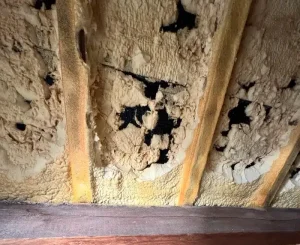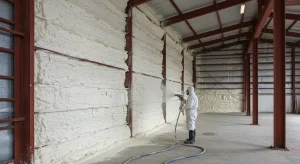Introduction
Home insulation plays a key role in reducing energy costs and maintaining a comfortable indoor environment. Choosing the right type can make a significant difference in energy efficiency, lowering heating and cooling expenses while improving overall home comfort. With various insulation materials and installation methods available, it is essential to understand the factors that determine the best option for different home structures and climates.
Understanding Insulation and Its Role in Energy Efficiency
Insulation reduces heat transfer, keeping warm air inside during winter and blocking heat from entering during summer. This minimizes reliance on heating and cooling systems, lowering energy consumption. The effectiveness of insulation depends on factors such as R-value, material type, and installation quality.
What is R-Value?
R-value measures an insulation material’s resistance to heat flow. A higher R-value means better thermal resistance. The appropriate R-value varies based on climate and home location. In colder regions, higher R-values are necessary to retain heat, whereas milder climates require moderate insulation levels.
Types of Home Insulation
Different insulation materials offer distinct benefits. Selecting the best option involves considering factors such as cost, installation method, and long-term performance.
Dense-Pack Cellulose
- Made from recycled paper fibers and densely packed into wall cavities.
- Provides excellent thermal resistance and soundproofing.
- Reduces air infiltration and improves energy efficiency.
Spray Foam Insulation
- Expands upon application, sealing gaps and cracks effectively.
- Provides high R-values, making it one of the most energy-efficient options.
- More expensive than other materials but offers superior long-term savings.
Loose Fill/Blown-In Cellulose
- Made from shredded, treated paper and blown into attics or wall cavities.
- Ideal for retrofitting existing homes or adding insulation to tight spaces.
- Provides excellent coverage and reduces heat loss effectively.
Cellulose Wall Insulation
- Designed for wall applications to improve energy efficiency.
- Helps control moisture and air movement.
- Offers superior soundproofing and thermal performance.
Factors to Consider When Choosing Insulation
Climate and Regional Requirements
Different regions require specific insulation strategies. Homes in northern states need higher R-values, while those in warmer areas benefit from radiant barriers and moderate insulation levels.
Cost and Long-Term Savings
While upfront costs vary, investing in higher-quality insulation can lead to significant energy savings over time. Spray foam, for instance, has a higher initial cost but lowers heating and cooling bills more effectively.
Installation Complexity
Some insulation types, like fiberglass batts, are DIY-friendly, while others, such as spray foam, require professional installation. Poorly installed insulation reduces efficiency, making proper application crucial.
Moisture Resistance and Durability
Homes in humid climates should use moisture-resistant insulation like closed-cell spray foam or rigid foam boards to prevent mold growth and structural damage.
Professional vs. DIY Insulation Installation
When to Consider DIY Installation
- Fiberglass batts and loose-fill cellulose are manageable for homeowners with basic skills.
- Proper installation techniques are necessary to prevent air gaps that lower effectiveness.
When to Hire a Professional
- Spray foam insulation requires specialized equipment and expertise.
- Homes with unique structures or hard-to-reach areas benefit from professional application.
- A trained installer ensures maximum energy efficiency and compliance with building codes.
Reducing Energy Bills with Proper Insulation
Well-installed insulation significantly cuts heating and cooling expenses. Pairing it with air sealing techniques—such as sealing cracks around doors, windows, and vents—enhances its effectiveness.
Looking for expert advice on selecting the right insulation for your home? Flatland Roofing & Insulation offers professional guidance and installation services to improve energy efficiency. Call (806) 606-6794 or email info@flatlandroofcoatings.com to schedule an assessment.
Common Questions About Home Insulation
1. How do I know if my home needs more insulation?
Signs include high energy bills, uneven indoor temperatures, and frequent HVAC cycling. Checking attic insulation levels can also help determine if additional insulation is needed.
2. What is the most cost-effective insulation option?
Fiberglass batts and blown-in cellulose offer good insulation at a lower cost. Spray foam, while more expensive, provides the best long-term savings.
3. Can I install new insulation over old insulation?
In many cases, yes. However, damaged, moldy, or compressed insulation should be removed before adding new layers.
4. How long does insulation last?
Most insulation materials last 20–80 years. Spray foam and rigid foam boards have the longest lifespan, while fiberglass and cellulose may require replacement sooner.
5. Does insulation help with noise reduction?
Yes, insulation materials like cellulose and fiberglass help absorb sound, reducing noise transfer between rooms or from external sources.
6. What type of insulation is best for an attic?
Blown-in cellulose, spray foam, or fiberglass batts are common choices for attics. The best option depends on climate and budget.
7. Is spray foam insulation worth the investment?
Spray foam offers high energy efficiency, air sealing, and moisture resistance. Though more expensive, it often pays for itself through energy savings.
8. Can I insulate my basement walls?
Yes, using moisture-resistant materials like rigid foam boards or closed-cell spray foam prevents mold growth and improves thermal performance.
9. Will insulation lower my heating and cooling costs?
Proper insulation reduces heat loss and gain, decreasing HVAC usage and lowering energy bills significantly.
10. How can I get a professional insulation assessment?
Contact Flatland Roofing & Insulation at (806) 606-6794 or email info@flatlandroofcoatings.com for an evaluation of your home’s insulation needs.





